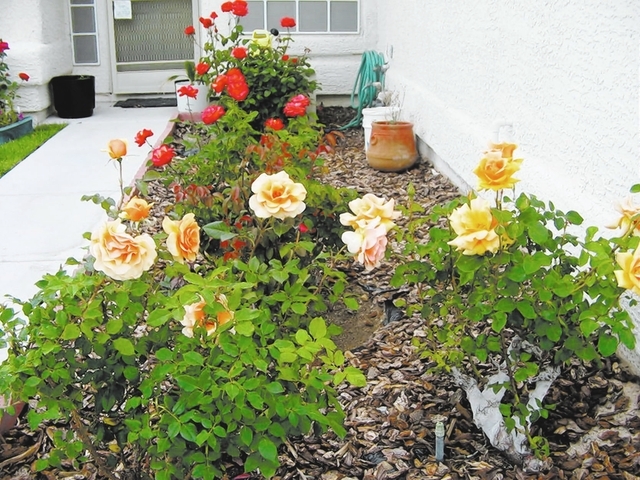Shredded wood works best as mulch for roses
Master Gardener Helen Brown presents All About Tomatoes at 9 a.m. Saturday at the UNCE orchard in North Las Vegas. Registration for Master Gardener morning classes beginning in March is now underway. For more information on both of these events, call the Master Gardener hotline at 702-257-5555.
Q. In previous years, I started fertilizing our roses in March. They performed poorly last year, so I want to feed them earlier. Is it OK to start now, and, if so, is there any special formula or nutrients required for the first feeding?
A. Roses perform best in shredded wood as surface mulch. You never want to grow roses in rock mulch which I see a lot in this town in case you are doing that. Doesn’t matter what you do, if they are in rock they will not look good in year three or four and beyond.
March should be OK but it would be nicer if you applied fertilizer a bit earlier, say in late January or early February. Roses perform better in soils enriched with compost, applied fertilizers high in phosphorus plus an iron fertilizer and wood mulch several inches deep.
Use a good quality rose fertilizer plus an application of iron chelate, preferably EDDHA, applied to the soil. There are other chelated iron fertilizers out there that are cheaper but this one is consistently the best iron chelate for our soils.
If you are applying iron to the foliage you will have to wait until they fully leaf out in about March. Foliar sprays should include a spreader or liquid detergent added to the spray solution at the very end of the mixing.
Q. When is a good time to cut off some of the bottom branches from my fig tree to make a new tree?
A. Figs are pretty easy to root provided you take the cuttings at the right time. February and March is the right time. You can root them in small pots or directly into the ground.
Cut last year’s growth, around pencil sized diameter, into pieces about 6-12 inches long. The bottom cut should be just below a bud. The top cut should be just above a bud. Let the cuts dry for 24 hours before sticking them in soil.
Stick them vertically into the soil so at least two buds are below ground. Roots can come from any place on the cutting that has a bud in contact with the soil. One bud above ground is all you will need, but it does not hurt to have a couple more above.
They will root faster if the soil is warm so find a warm location for the potted cutting like on top of the refrigerator if indoors. If the soil is warm you could expect roots in about three to four weeks.
I would stick several in the same container a few inches apart in case some don’t take. As soon as you see leaves, put them outside in the sun.
The easiest way is to stick them directly into the soil where you want it to root and then you don’t have to replant them. If your limbs are low enough you can bend attached limbs into a trench in the ground, peg them so they stay put, water the trench and mulch the soil.
They will root directly in the soil while still attached to the tree. As soon as you detect roots forming or new growth, cut the rooted limb from the tree and transplant it.
Use amended garden soil (with compost) or potting soil any time you are starting cuttings from plants. Make sure the soil drains easily. Other alternative rooting media are perlite, coarse sand and vermiculite.
Q. I was checking the mulch products locally and one company has a product called Ferta Mulch. They label it “Humic Composted Mulch.” It looks like finely chopped up bark. They recommend it to improve the quality of your soil and have a picture of it on their website. I’m expanding my vegetable garden so bags are out of the question.
A. I don’t know this product so it is hard for me to judge. Looks, smell and how it feels are not always the only things when judging composts. This is going into your garden and it will impact your garden for a long time to come.
If there is something in it that is detrimental, like high boron, it could impact your production for years to come. You cannot tell if high boron is present, for instance, by looking at it.
Any company selling compost should be conducting regular testing and provide reports available to you regarding the level of quality of their product. This should include chemical, physical and reports on biological activity. All of these are important.
I have reviewed regular reports from ViraGrow regarding the compost they began importing into the valley last summer. The reports look very good. I will be conducting some other tests, including some trials of their product, in the coming months. Stay tuned on my blog.
Bob Morris is a horticulture expert living in Las Vegas and professor emeritus for the University of Nevada. Visit his blog at xtremehorticulture.blogspot.com. Send questions to Extremehort@aol.com.

















